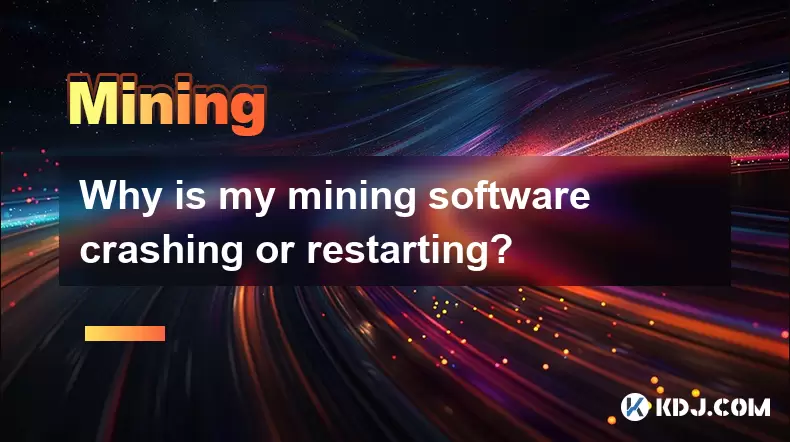-
 bitcoin
bitcoin $118548.520763 USD
3.67% -
 ethereum
ethereum $4352.564943 USD
4.79% -
 xrp
xrp $2.964058 USD
4.22% -
 tether
tether $1.000565 USD
0.05% -
 bnb
bnb $1028.372955 USD
1.46% -
 solana
solana $221.373507 USD
6.00% -
 usd-coin
usd-coin $0.999933 USD
0.02% -
 dogecoin
dogecoin $0.248633 USD
6.85% -
 tron
tron $0.341444 USD
2.38% -
 cardano
cardano $0.852946 USD
5.82% -
 hyperliquid
hyperliquid $47.869306 USD
6.15% -
 chainlink
chainlink $22.561476 USD
6.01% -
 ethena-usde
ethena-usde $1.001258 USD
0.05% -
 avalanche
avalanche $30.660000 USD
2.06% -
 stellar
stellar $0.400917 USD
9.76%
Why is my mining software crashing or restarting?
Mining software crashes are often caused by overheating, insufficient power, driver issues, or misconfigured settings—monitor temps, update drivers, and validate config files to maintain stability.
Aug 11, 2025 at 11:15 am

Understanding Common Causes of Mining Software Crashes
Mining software instability can stem from multiple sources, and identifying the root cause is essential for maintaining consistent hash rates and profitability. One of the most frequent triggers is overheating of GPU or ASIC hardware. When components exceed safe thermal thresholds, the system may force a shutdown or restart to prevent permanent damage. Monitoring tools like HWInfo or MSI Afterburner can help track temperature in real time. If GPU temperatures consistently exceed 85°C, thermal throttling or crashes are likely. Ensuring proper airflow, cleaning dust from heatsinks, and reapplying thermal paste may resolve this issue.
Another common culprit is insufficient power delivery. Mining rigs, especially those with multiple GPUs, demand stable and adequate power. Using a power supply unit (PSU) that does not meet the total wattage requirements or has failing rails can lead to sudden shutdowns. A PSU operating near its maximum capacity may trigger over-current protection. To verify power stability, check for PSU wattage ratings versus total system draw. It is advisable to use a PSU with at least 20% more capacity than the rig’s peak consumption and to use high-quality, modular units from reputable brands.
Driver and Software Compatibility Issues
Outdated or incompatible drivers are a major cause of mining software instability. Using outdated GPU drivers—especially on NVIDIA or AMD cards—can lead to memory leaks, kernel panics, or application crashes. Always ensure you are running the latest stable driver version optimized for mining, such as NVIDIA’s 522.06 or AMD’s Adrenalin 22.5.1. Some miners prefer older, more stable versions known for better performance under load.
Equally important is matching mining software to your hardware and operating system. For example, using T-Rex Miner on a system with unsupported GPU architectures can cause immediate crashes. Always download mining software from official sources and confirm compatibility with your GPU model. If using Windows, ensure you have the correct Visual C++ Redistributables and .NET Framework installed. On Linux, confirm that your kernel version supports the mining daemon and that necessary libraries like OpenSSL are present.
Memory and VRAM Instability
Mining places extreme stress on GPU memory, and unstable VRAM is a leading cause of crashes. Overclocking VRAM too aggressively can result in memory errors, manifesting as screen artifacts, driver timeouts, or complete miner failure. To test VRAM stability, run a memory stress test using tools like memtestCL or OCCT. If errors appear, reduce the memory clock incrementally until stability returns.
Additionally, insufficient GPU memory (VRAM) can cause crashes when mining algorithms with high memory requirements, such as Etchash or KawPow. For instance, Ethereum Classic mining requires at least 4GB of VRAM, and cards with less may fail during DAG generation. Always verify that your GPU meets the minimum VRAM requirements for the chosen algorithm. You can also reduce the DAG size by adjusting parameters like --dual-mode off in some miners, though this may affect profitability.
Configuration File Errors
Misconfigured miner settings are a frequent but often overlooked cause of crashes. Incorrectly formatted config files—such as missing commas, extra brackets, or invalid parameters—can prevent the miner from launching properly. Always validate your configuration using a JSON validator if applicable. For example, in GMiner, a missing quotation mark around a pool URL will cause immediate failure.
Common misconfigurations include:
- Specifying a non-existent mining pool or incorrect port
- Using unsupported intensity or thread values
- Enabling features like API monitoring on a port already in use
- Forgetting to set the wallet address or worker name
To troubleshoot, start with a minimal configuration and gradually add parameters. Use the --debug or --log flag to generate detailed logs. These logs often reveal the exact line or setting causing the crash. For example, a log entry like Connection refused on port 4444 indicates a pool connectivity issue, not a software defect.
Operating System and Background Process Conflicts
Mining software can conflict with background applications or system settings. Antivirus or firewall software may flag miner executables as malicious and terminate them. Add the miner folder to your antivirus exclusion list and disable real-time scanning for that directory. On Windows, disable Windows Defender’s Controlled Folder Access if it blocks write operations.
Power management settings can also interfere. Windows power plans set to 'Balanced' or 'Power Saver' may throttle GPU performance or cause driver resets. Switch to 'High Performance' mode. On Linux, ensure that CPU frequency scaling is set to 'performance' using cpufreq-set -g performance.
Background processes like browser tabs, streaming software, or other GPU-intensive applications can consume resources and destabilize the miner. Close unnecessary programs. Use Task Manager or htop to monitor CPU, RAM, and GPU usage. If system memory usage exceeds 90%, consider adding more RAM or reducing the number of concurrent processes.
Hardware Failures and Degradation
Even with optimal settings, underlying hardware issues can cause persistent crashes. Failing capacitors, damaged VRMs, or degraded memory chips on the GPU may not be immediately visible but can cause intermittent crashes under load. Inspect your cards for physical signs of damage, such as bulging capacitors or burn marks.
A faulty PCIe riser or motherboard slot can also lead to instability. Try moving the GPU to a different riser or slot to isolate the issue. Use a powered riser with a stable 12V supply, as unpowered ones may cause voltage drops. Test each GPU individually to identify if one specific card is triggering system-wide crashes.
Memory degradation over time, especially in GPUs used for long-term mining, can lead to increasing error rates. Run extended stress tests lasting 12+ hours to observe stability. If one GPU consistently fails while others remain stable, it may be nearing end-of-life and should be replaced.
Frequently Asked Questions
Why does my miner crash only after several hours of operation?This is typically due to thermal buildup or memory degradation over time. Initially, temperatures are within limits, but as heat accumulates and cooling becomes less effective, components exceed thresholds. Monitor temperature trends over time and ensure fans are operating at appropriate speeds.
Can using too many GPUs on one motherboard cause crashes?Yes. Exceeding the motherboard’s PCIe lane capacity or power delivery limits can cause instability. Most consumer motherboards support up to 6–8 GPUs reliably. Ensure your BIOS supports multi-GPU setups and that you are using PCIe bifurcation correctly.
Why does my miner restart when I remote into the rig?Remote desktop tools like RDP can cause GPU driver resets, especially on Windows. Use headless mode solutions such as Parsec, TeamViewer, or VNC, or switch to a Linux-based mining OS like HiveOS or RaveOS to avoid driver conflicts.
Is it safe to leave a crashing miner running unattended?No. Repeated crashes can cause file system corruption, DAG generation errors, or hardware stress. Investigate and resolve the root cause before resuming unattended operation. Use monitoring tools to receive alerts when crashes occur.
Disclaimer:info@kdj.com
The information provided is not trading advice. kdj.com does not assume any responsibility for any investments made based on the information provided in this article. Cryptocurrencies are highly volatile and it is highly recommended that you invest with caution after thorough research!
If you believe that the content used on this website infringes your copyright, please contact us immediately (info@kdj.com) and we will delete it promptly.
- BlockDAG, DOGE, HYPE Sponsorship: Crypto Trends Shaping 2025
- 2025-10-01 00:25:13
- Deutsche Börse and Circle: A StableCoin Adoption Powerhouse in Europe
- 2025-10-01 00:25:13
- BlockDAG's Presale Buzz: Is It the Crypto to Watch in October 2025?
- 2025-10-01 00:30:13
- Bitcoin, Crypto, and IQ: When Genius Meets Digital Gold?
- 2025-10-01 00:30:13
- Stablecoins, American Innovation, and Wallet Tokens: The Next Frontier
- 2025-10-01 00:35:12
- NBU, Coins, and Crypto in Ukraine: A New Yorker's Take
- 2025-10-01 00:45:14
Related knowledge

The difference between staking and mining
Sep 24,2025 at 05:18am
Understanding Staking in the Cryptocurrency Ecosystem1. Staking involves holding funds in a cryptocurrency wallet to support the operations of a block...

How to participate in testnet mining?
Sep 22,2025 at 09:18am
Understanding Testnet Mining in the Crypto Ecosystem1. Testnet mining is a method used by blockchain developers to simulate real-world conditions on a...

How to dispose of abandoned mining machines?
Sep 19,2025 at 08:19pm
Assessing the Condition of Abandoned Mining Rigs1. Begin by inspecting each mining machine for visible damage, corrosion, or missing components. Machi...

How to identify high-quality mining pools?
Sep 21,2025 at 03:19pm
Reputation and Track Record1. A mining pool’s reputation is built over time through consistent performance and transparency. Pools that have operated ...

Advantages of decentralized mining pools
Sep 20,2025 at 04:36pm
Enhanced Security and Resistance to Censorship1. Decentralized mining pools operate on blockchain-based smart contracts, eliminating the need for a ce...

What is mining machine overclocking?
Sep 21,2025 at 07:19pm
Understanding Mining Machine Overclocking1. Mining machine overclocking refers to the process of increasing the operating frequency of a cryptocurrenc...

The difference between staking and mining
Sep 24,2025 at 05:18am
Understanding Staking in the Cryptocurrency Ecosystem1. Staking involves holding funds in a cryptocurrency wallet to support the operations of a block...

How to participate in testnet mining?
Sep 22,2025 at 09:18am
Understanding Testnet Mining in the Crypto Ecosystem1. Testnet mining is a method used by blockchain developers to simulate real-world conditions on a...

How to dispose of abandoned mining machines?
Sep 19,2025 at 08:19pm
Assessing the Condition of Abandoned Mining Rigs1. Begin by inspecting each mining machine for visible damage, corrosion, or missing components. Machi...

How to identify high-quality mining pools?
Sep 21,2025 at 03:19pm
Reputation and Track Record1. A mining pool’s reputation is built over time through consistent performance and transparency. Pools that have operated ...

Advantages of decentralized mining pools
Sep 20,2025 at 04:36pm
Enhanced Security and Resistance to Censorship1. Decentralized mining pools operate on blockchain-based smart contracts, eliminating the need for a ce...

What is mining machine overclocking?
Sep 21,2025 at 07:19pm
Understanding Mining Machine Overclocking1. Mining machine overclocking refers to the process of increasing the operating frequency of a cryptocurrenc...
See all articles










































































